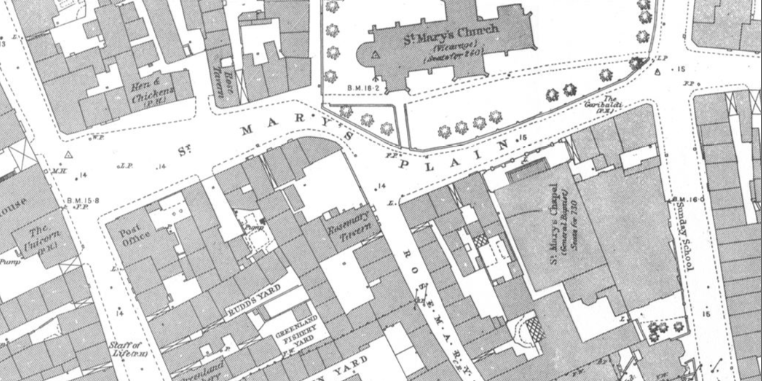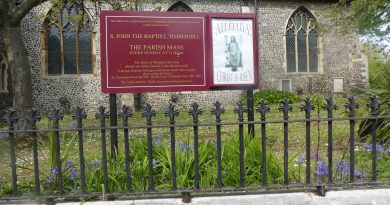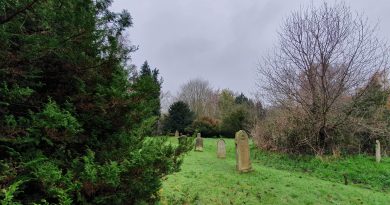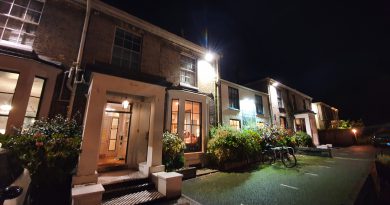Norwich – Pykerell’s House
I’ve managed to walk by this building on Rosemary Road, off St. Mary’s Plain, on probably hundreds of occasions and I’ve failed to realise that it’s one of the oldest inhabited residences in Norwich. It’s also one of only six thatched buildings still remaining in Norwich and much more lies behind this frontage that might initially be thought.
A plaque on the wall, placed there by the Norfolk Archaeological Trust. It reads:
“In this 15th century house, Pilgrim’s Hall and latterly Old Rosemary Tavern, lived Thomas Pykerell, mercer and thrice Mayor of Norwich in 1525, 1533 and 1538”.
I’d add that there’s a comprehensive set of old photos and a plan of the building that was prepared by George Plunkett and it’s in the Rosemary Lane section of that web-page. He quotes the Rev JF Williams who wrote in the Archaeological Journal in 1949:
“This is the southern part of a late 15th century merchant’s house, which seems originally to have had a further extension to the north. In the centre of what remains is a small open hall (20 feet by 16 feet) with a fine open roof of tie-beam and queen-post construction. There was a bay-window recess on either side, the moulded rear arch of that on the north side still intact, while considerable indications of that on the south side remain. In the spandrels of the arches were four shields, now blank, but which once bore (Kirkpatrick’s Notes) the arms of Pykerell with his merchant’s mark, together with the arms of Norwich City and of the Mercers’ Company. At the lower (eastern) end of the hall is the original stud-partition wall, which still retains the framework of three doors, leading to pantry, buttery and cellar. The kitchen (now no longer in existence) was probably further to the north, on the site now covered by a later building, and reached from the hall by passing through a courtyard. Early in the 16th century this end of the house seems to have been reconditioned. At the further west end is the former parlour with its large fire-place having moulded brick jambs. This room seems to have been reached by a lobby off the northern bay-window recess, in the west wall of which the top of a door-frame survives. Over this parlour is a large upper room originally reached by a separate staircase. Early in the 17th century a floor was inserted in the hall, and windows to light the upper part were made in the south wall.
The house was apparently first known as Pilgrims’ Hall, but it seems undoubtedly to have been built and inhabited by Thomas Pykerell, mercer, who was three times Mayor of Norwich, in 1525, 1533 and 1538. In the 19th century it became a licensed house and was known as the Rosemary Tavern. It so continued until 1931, when it was included in a slum-clearance scheme, but being bought by the Norfolk Archaeological Trust, its present owners, it was reconditioned and so saved from destruction. In the 1942 blitz the thatch was entirely burnt off and much damage was done to the building. It was saved by the Ancient Monuments Division of the Ministry of Works, who prevented demolition and did such first-aid repairs as were possible at the time, but for six years it remained empty and in a semi-ruinous condition. It has lately again been reconditioned and is now one of the oldest inhabited houses in Norwich.”
In the 1880s, the building was in use as the Rosemary Tavern and it had been a licensed premises since the 1830s and was also in use as a shop. During the attempt to reduce the number of licensed premises in the city in the early twentieth century, the Tavern’s license was lost and it closed as a pub in 1908.
As suggested by Williams, this building is indeed a remarkable survivor, although it does feel a little out of place given the buildings around it today. That it nearly fell to slum clearance is testament to how many historic structures in Norwich were lost at that time, and ironically some would today be considered as quite desirable residences with a little (well, quite a lot of) repair.
The damage done to the structure in the 1942 Blitz was substantial, the thatch went and most of the roof structure was very badly damaged. There must have been moments when the building, having just survived slum clearance, was seriously threatened. So, as the heritage record notes, there is much modern about this building because of the war damage that needed repairing, but it still retains its historic core. It’s a shame it’s not a pub still though, I imagine it might have looked a little like the Lattice House in King’s Lynn which shares a similar construction date and original usage.







